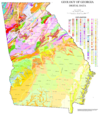User:Abyssal/Portal:Ordovician
IntroductionThe Ordovician (/ɔːrdəˈvɪʃi.ən, -doʊ-, -ˈvɪʃən/ or-də-VISH-ee-ən, -doh-, -VISH-ən) is a geologic period and system, the second of six periods of the Paleozoic Era. The Ordovician spans 41.6 million years from the end of the Cambrian Period 485.4 Ma (million years ago) to the start of the Silurian Period 443.8 Ma. The Ordovician, named after the Welsh tribe of the Ordovices, was defined by Charles Lapworth in 1879 to resolve a dispute between followers of Adam Sedgwick and Roderick Murchison, who were placing the same rock beds in North Wales in the Cambrian and Silurian systems, respectively. Lapworth recognized that the fossil fauna in the disputed strata were different from those of either the Cambrian or the Silurian systems, and placed them in a system of their own. The Ordovician received international approval in 1960 (forty years after Lapworth's death), when it was adopted as an official period of the Paleozoic Era by the International Geological Congress. Life continued to flourish during the Ordovician as it did in the earlier Cambrian Period, although the end of the period was marked by the Ordovician–Silurian extinction events. Invertebrates, namely molluscs and arthropods, dominated the oceans, with members of the latter group probably starting their establishment on land during this time, becoming fully established by the Devonian. The first land plants are known from this period. The Great Ordovician Biodiversification Event considerably increased the diversity of life. Fish, the world's first true vertebrates, continued to evolve, and those with jaws may have first appeared late in the period. About 100 times as many meteorites struck the Earth per year during the Ordovician compared with today. (Full article...) Selected article on the Ordovician world and its legaciesThe exposed geology of the Death Valley area presents a diverse and complex set of at least 23 formations of sedimentary units, two major gaps in the geologic record called unconformities, and at least one distinct set of related formations geologists call a group. The oldest rocks in the area are extensively metamorphosed by intense heat and pressure and are at least 1700 million years old. These rocks were intruded by a mass of granite 1400 Ma (million years ago) and later uplifted and exposed to nearly 500 million years of erosion. Marine deposition occurred 1200 to 800 Ma, creating thick sequences of conglomerate, mudstone, and carbonate rock topped by stromatolites, and possibly glacial deposits from the hypothesized Snowball Earth event. Rifting thinned huge roughly linear parts of the supercontinent Rodinia enough to allow sea water to invade and divide its landmass into component continents separated by narrow straits. A passive margin developed on the edges of these new seas in the Death Valley region. Carbonate banks formed on this part of the two margins only to be subsided as the continental crust thinned until it broke, giving birth to a new ocean basin. An accretion wedge of clastic sediment then started to accumulate at the base of the submerged precipice, entombing the region's first known fossils of complex life. These sandy mudflats gave way about 550 Ma to a carbonate platform which lasted for the next 300 million years of Paleozoic time. (see more...) Selected article on the Ordovician in human science, culture and economics
The geologic map of Georgia (a state within the United States) is a special-purpose map made to show geological features. Rock units or geologic strata are shown by colors or symbols to indicate where they are exposed at the surface. Structural features such as faults and shear zones are also shown. Since the first national geological map, in 1809, there have been numerous maps which included the geology of Georgia. The first Georgia specific geologic map was created in 1825. The most recent state-produced geologic map of Georgia, by the Georgia Department of Natural Resources is 1:500,000 scale, and was created in 1976 by the department's Georgia Geological Survey. It was generated from a base map produced by the United States Geological Survey. The state geologist and Director of the Geological Survey of Georgia was Sam M. Pickering, Jr. Since 1976, several geological maps of Georgia, featuring the state's five distinct geologic regions, have been produced by the federal government. (see more...)
Selected image
Did you know?
Need help?Do you have a question about Abyssal/Portal:Ordovician that you can't find the answer to? Consider asking it at the Wikipedia reference desk. TopicsEpochs - Early Ordovician - Middle Ordovician - Late Ordovician Landmasses - Baltica - Gondwana - Laurentia - Siberia Fossil sites - Beecher's Trilobite Bed - Walcott–Rust quarry Researchers - Charles Emerson Beecher - Charles Lapworth - Charles Doolittle Walcott Quality ContentFeatured Ordovician articles - None SubcategoriesRelated contentAssociated WikimediaThe following Wikimedia Foundation sister projects provide more on this subject:
|






















